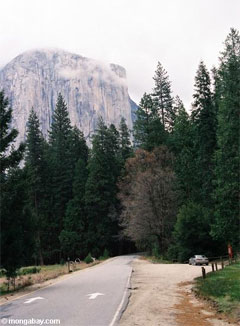Low-use and abandoned logging roads negatively impact wildlife in the United States
Low-use and abandoned logging roads negatively impact wildlife in the United States
Rhett Butler, mongabay.com
November 1, 2006
A new study says that forest roads adversely affect wildlife populations.
Writing in an article to be published in the journal Conservation Biology, researchers at the University of Missouri-Columbia have found that low-use and abandoned logging, mining, and oil access roads create a significant ecological footprint’ in heavily forested areas.
“Our results may exemplify a problem created by current and past land use activities in all forested regions, especially those related to road building for natural-resource extraction,” said Ray Semlitsch, a University of Missouri-Columbia professor of biology and lead investigator in the study. “The problem we revealed points to a potential failure of forest managers and policy makers to realize that the effect of roads reaches well beyond their boundaries and that abandonment or the decommissioning of roads does not mean detrimental ecological effects disappear. Current management decisions have significant repercussions for generations to come.”

|
Semlitsch and colleagues monitored salamander populations in Nantahala National Forest of North Carolina and found that salamander abundance was reduced in areas near low-use and abandoned roads.
“Woodland salamanders are small, lungless, sedentary and strongly dependent on cool, moist forest habitat, which makes them excellent indicators of environmental stress or change,” Semlitsch said. “Our study found that forest roads negatively impact salamanders and probably other forms of wildlife as well. Extraction of timber 80 years ago has created a significant ecological footprint’ in a forest that supersedes regeneration of the forest itself. Assuming current timber management practices harvest trees at intervals of 80 to 100 years, footprints of logging roads from past harvests will not be gone before a new footprint is laid down, and effects will accumulate over time, eventually fragmenting forests into ever-smaller patches of suitable habitat.”
According to a release from the University of Missouri-Columbia,
-
The study used a model to predict how much of the national forest was potentially unsuitable for salamanders due to roads and road-effect zones around roads. Using a relatively conservative road-effect size of 35 meters on each side of a road, the study found that 28.6 percent of the entire district was unsuitable habitat for the salamanders; using a higher estimate of 60 to 80 meters based on their work and others, the percentage of unsuitable forest habitat rose to between 36.9 and 42.8 percent.
The findings are significant in the light of the federal government’s decision in May to repeal a rule that banned road construction, logging and other development in some 58.5 million acres of roadless public land. Conservation biologists say the repeal of the “roadless rule” will increase the ‘human footprint’ on pristine wildlands in the United States as some 34.3 million acres of land are newly open to road construction.
Dr. Eric Sanderson, a scientist with the Wildlife Conservation Society, has developed a scientific mapping exercise called the Human Footprint that specifically looked at roadless areas in both the U.S. and overseas. Sanderson found that the most important contributor to human influence at the global scale is roads.
“Roads are terrific at providing human access to areas, but unfortunately they bring with that access a host of ecological problems,” said Sanderson in a statement released last year. “Roads contribute direct mortality to wildlife through roadkill, are conduits for the introduction of new species to an area, and modify the hydrological conditions of watercourses that pass by them.”
California has already sued the Bush Administration over the repeal of the Clinton era “Roadless Rule”.
This article is based on a news release from the University of Missouri-Columbia and previous mongabay.com articles.